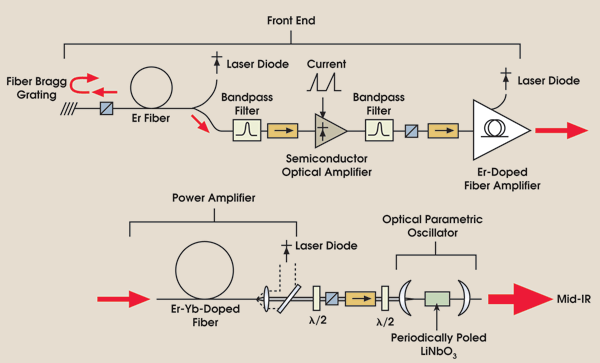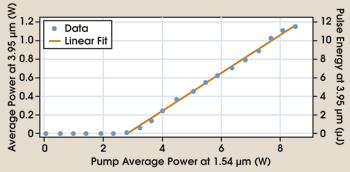
Mid-Infrared Pulses Generated from Eye-Safe Fiber
Parametric oscillator converts eye-safe wavelengths to mid-IR.
Breck Hitz
Mid-infrared sources are crucial in several applications, including molecular spectroscopy and military countermeasures, and many investigators around the world are pursuing approaches to practical, efficient sources in this spectral region. These approaches include nonlinear conversion of shorter wavelengths into the mid-IR as well as quantum-cascade lasers and several types of rare-earth-doped lasers that operate in this region.
Investigators at Aculight Corp. in Bothell, Wash., have taken the latter approach, using an optical parametric oscillator to convert the output of an eye-safe amplified-stimulated-emission (ASE) source into watt-level average powers in the 3- to 5-μm region.
They believe that they are only the second group to base a mid-IR parametric oscillator on an eye-safe fiber source, and that their results reflect a significant advance on earlier work. Many previous investigators have developed mid-IR parametric oscillators starting with 1-μm ytterbium or neodymium sources. Beginning with an eye-safe source (i.e., one in the vicinity of 1.5 μm, where the cornea blocks light from reaching the retina) has one significant advantage: It can utilize rugged and reliable commercial devices developed for the telecom industry, whose heavily used C-band (1530 to 1565 nm) coincidentally falls into the eye-safe region.
Unlike many other approaches to mid-IR sources, the one described here begins not with a laser but with amplification of an ASE source. The advantage is that it decouples many of the operational parameters, such as pulse duration and energy, so that they can be adjusted individually to meet the requirements of a particular application.

Figure 1. The mid-IR source started with an amplified ASE source, whose output pumped an optical parametric oscillator. The front end was built entirely from commercial telecom-ready products. Reprinted with permission of Optics Letters.
The scientists began with a diode-pumped, double-pass fiber ASE source (Figure 1). A bandpass filter selects a spectral slice of the output, which passes on to a pulse-pumped semiconductor optical amplifier and then to an erbium-doped fiber amplifier. The 30-mW output of this amplifier, whose pulse duration, repetition frequency and wavelength can be independently set, then enters an erbium-ytterbium-doped fiber amplifier.
This final amplification stage is a 1.6-m-long double-clad fiber with an ~15-μm mode-field diameter, which is backward-pumped by a 976-nm, 50-W, fiber-coupled diode bar from Limo Mikrooptik of Dortmund, Germany. The scientists adjusted the system parameters so that the output of the amplifier was a polarized train of 1545-nm, 8-ns pulses containing 100 μJ, at a 100-kHz repetition rate. They believe that these are the highest pulse energies and average powers reported from a polarized, eye-safe pulsed fiber source. The 10-W output beam was slightly astigmatic, with measured M2 values of 1.3 and 1.7 in the two orthogonal directions.
A 30-mm-long periodically poled lithium niobate crystal in the parametric oscillator converted the output of the final fiber amplifier into the mid-IR. The oscillator was singly resonant at the signal wavelengths between 2.5 and 2.6 μm, and the crystal was antireflection-coated at those wavelengths as well as at the pump wavelength (1.5 μm) and at the idler wavelengths (3.8 to 4.1 μm).

Figure 2. Tuning the idler to 3.95 μm, the scientists observed more than a watt output from the optical parametric oscillator in Figure 1.
The scientists tuned the oscillator’s idler between 3.8 and 4.0 μm by focusing into the appropriate poling period in the crystal and observed a steady output in excess of 1 W (Figure 2). The quality of the beam (M2 of 1.85 and 2.05 in the two directions) was somewhat poorer than the pump beam, apparently because of mode mismatch and thermal focusing in the resonator.
Investigating the oscillator’s behavior at longer wavelengths, the researchers substituted a periodically poled, MgO-doped LiNbO3 crystal and observed 0.25-W average power at 4.5 μm. The oscillator’s threshold and efficiency were both poorer in this case than at shorter wavelengths because of the nonlinear crystal’s greater absorption at 4.5 μm.
Optics Letters, Jan. 1, 2007, pp. 56-58.
/Buyers_Guide/Lockheed_Martin_Laser_and_Sensor_Systems/c167